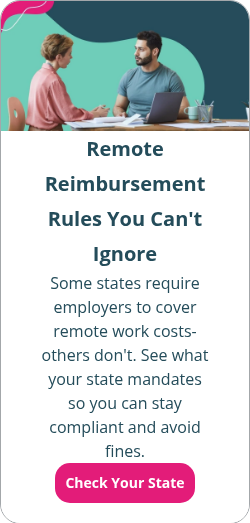How to set up a cell phone reimbursement policy
By Chase Charaba on January 2, 2024 at 7:43 AM
When providing an employee expense reimbursement program, many organizations reimburse employees for their work-related expenses like laptops, software fees, and home internet bills for remote workers. But, some organizations stop short of reimbursing employees for cell phone expenses.
Few organizations offer employer-provided cell phones, so most employees worldwide use their personal cell phones for business purposes. Marketers use their phones to post on social media or shoot quick videos, and outside sales representatives use them to take work-related calls on the go, for example. In some industries, cell phones are an essential tool for employees.
If your employees use their cell phones for work-related purposes, you can set up a cell phone reimbursement policy that outlines your procedures for compensating employees for their personal cell phone use.
In this article, we'll explain how to set up a mobile phone reimbursement policy. It will also explore why your organization should consider a mobile device reimbursement program.
Have questions about reimbursing your employees' health costs? Get answers.
Takeaways from this blog post:
- Many organizations reimburse employees for work-related expenses, but some don't include cell phone expenses in their reimbursement program.
- Cell phones are essential tools for employees in many industries, and offering reimbursement for their use can help reduce turnover and attract and retain employees.
- Some states require employers to reimburse employees for business expenses, including cell phone usage, and failure to do so can result in legal issues.
Why should employees receive cell phone allowances?
Offering a comprehensive benefits package is essential for attracting and retaining employees. Your employees will be more productive and less likely to leave your organization when they receive benefits they value.
Providing monthly payments for personal cell phone plans is a perk that can go a long way toward reducing turnover.
Attracting and retaining employees isn't the only reason to offer monthly reimbursements. There are also state regulations to consider.
Currently, 11 states, the District of Columbia, and the city of Seattle require employers to reimburse their employees for necessary work-related expenses. States like California and Illinois specifically require reimbursement for employee cell phone expenses.
Without a monthly stipend, your employees in these states could sue your organization for unpaid wages. That's what happened in 2022 when California employees sued Amazon1 for uncompensated remote work expenses, including work-related use of mobile devices.
While state and local laws don’t require you to reimburse employees for mobile phone expenses in most places, it's still an excellent benefits option. That's because many employees want remote work expense reimbursement. Our 2022 Employee Benefits Survey Report shows that 47% of remote workers value internet or phone reimbursement. Additionally, 39% of hybrid employees and 27% of in-office workers value these benefits.
What is a cell phone stipend?
One of the most common ways to reimburse employees for their cell phones is with a cell phone or remote work stipend. A cell phone stipend is a sum of money employers provide to employees to pay for their cell phone plans. Sometimes, employers provide a lump sum or an annual allowance. Many employers, however, choose a monthly or quarterly allowance.
This allows you to pay for a reasonable percentage of your employees' personal phone costs when they use their devices for work. For example, you could offer all your full-time employees a $100 monthly allowance. This would cover most of your employees' monthly cell phone bills, as the average monthly cell phone bill—According to J.D. Power2—is $127.37.
For states that require cell phone expense reimbursement, you'd need to provide a large enough allowance to cover the entire cost of your employees' work-related phone expenses. However, in other states, the amount you choose to offer is entirely up to you.
Is cell phone reimbursement taxable by the IRS?
Reimbursements made for work-related personal cell phone use aren't taxable. The IRS issued special guidance for the tax treatment of personal cell phones in IRS-2011-933. To qualify for nontaxable reimbursements, the use of personal cell phones must not be primarily for business purposes.
If you want your reimbursements to be tax-free, there are a few extra steps to take. You must submit documentation to the IRS proving that using personal phones is necessary for employees to do their jobs. Otherwise, the IRS considers it a taxable benefit.
Employers can also provide employees with cell phones for substantial business reasons. This is a tax-free fringe benefit, provided you don’t offer the phone as a perk.
If you reimburse employees for non-business-related cell phone use, that amount is always taxable.
What is the average cell phone reimbursement amount?
As you set up a compliant cell phone reimbursement policy for your organization, you might wonder what other organizations offer for their mobile phone stipends.
According to the SHRM's 2023 Employee Benefits Survey4, 59% of organizations offer reimbursement for work equipment. Those employers offered an average of $857 to employees for all remote work expenses combined.
A 2022 study by Samsung and Oxford Economics5 found that the average mobile device reimbursement was between $30 and $50 per month. According to the report, this averages out to $40.20 each month or $482 annually.
How to create a "bring your own device" policy
Bring your own device (BYOD) policies are the formal structure behind mobile stipends for existing personal devices. You should include these policies in your employee handbook. BYOD policies should cover what devices employees must acquire on their own and which devices and tools you’ll provide to them.
You should also include any necessary security measures for keeping company information safe. This could include confidentiality agreements, requiring the use of VPNs, and having your IT department install anti-virus software on mobile devices.
You'll also need to outline your employee reimbursement policy. This includes how often you'll provide mobile reimbursements, your allowance amount, and any other rules or conditions that accompany your stipend program. This includes any prerequisites such as submitting receipts or filing an expense report.
Remote work and equipment stipends
You can also create an attractive benefits package that works for all your employees regardless of their personal cell phone use.
When you offer a remote work stipend, you can provide your employees with an annual, quarterly, or monthly allowance for their home office and work equipment costs. Simply provide an allowance for certain eligible expenses, such as internet connection costs or cell phones, or one allowance for all remote work-related expenses.
An employee can then request reimbursement for their remote work expenses. They’ll simply submit a receipt with their expense through our software. You'll then approve these amounts up to their eligible allowance. This allows your employees to choose which remote work expenses matter most to them.
Conclusion
A cell phone reimbursement agreement can help you attract and retain employees, especially remote and field workers, while avoiding potential litigation in states that require employee expense reimbursement.
In addition to having a written cell phone policy, offering an employee stipend can help you easily pay for employees' mobile expenses while avoiding the higher cost of employer-provided cell phones.
This blog article was originally published on November 9, 2022. It was last updated on January 2, 2024.
- https://www.shrm.org/resourcesandtools/hr-topics/benefits/pages/lawsuits-put-spotlight-on-paying-remote-workers-expenses.aspx
- https://www.jdpower.com/business/tmt/us-wireless-total-ownership-experience-study
- https://www.irs.gov/pub/irs-news/ir-11-093.pdf
- https://www.shrm.org/hr-today/trends-and-forecasting/research-and-surveys/Pages/Employee-Benefits-Survey.aspx
- https://insights.samsung.com/2022/05/16/how-much-should-you-compensate-byod-employees-for-mobile-expenses-3/#:~:text=What%20is%20the%20average%20mobile,per%20year%20for%20each%20employee
Check out more resources
See these related articles

Types of employee reimbursements
Explore the different types of employee reimbursements, like travel, healthcare, and more. Learn how reimbursements benefit both employees and employers.

How to attract talent in the gig economy
Looking to attract gig workers to your business? Discover effective strategies for hiring and retaining talent in the gig economy with this guide.

Remote employee reimbursement rules by state
Discover remote employee reimbursement rules by state. Learn how to stay compliant with employee expense reimbursement laws across the U.S.



